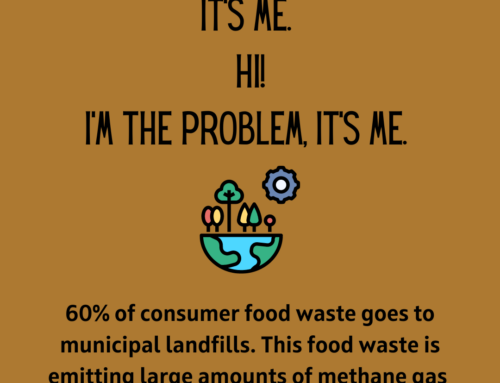I generally blog about food and nutrition topics, and am known to clear up the plethora of misinformation that’s out there. Today, however, I wanted to write a story. I’m weaving in information about the important role pollinators in our food supply, but overall, this isn’t a food and nutrition story. It’s a story about passion and wonder. A reminder for parents, and for adults without children alike: Stay curious.
Reflecting on Early Interests
I have often told new parents that “what you see at age 3, is what you get”. At least in my experience as a parent, this has been shown to be true. I’ve also heard life coaches say things like “what did 8 year old you like to do?”, to help people find their priorities, key interests, and values. When I look back to my own childhood interests, I was always outside, riding my bike or playing ball. I can tell you that the “B” (for birds) encyclopedia was the most referenced book in the set every summer. I had a subscription to Tennis magazine in middle school and Discover magazine in high school. And I always looked up at the night sky in wonder. Of course, I also loved food, and enjoyed helping my Italian American mom prep and set up for parties and picnics.
What did you or your children enjoy thinking about or doing as a child?
Nature and Nurture
When my children were young, we read a lot of books together. Nearly every night included a few (or many) bedtime stories. I always found it interesting to learn how each of my children were drawn to different genres, even when it came to the children’s books read to them as young as two or three years old. Our oldest loved fantasy, fables, and silly stories. Our middle was all business and had no time for silliness or fantasy. He wanted to learn how trucks and planes worked. Our youngest was drawn to all books covering animals and nature. This story is about how a child’s wonder, can turn into a joyful career.
Once upon a time, there was a very hungry caterpillar…
I’m sure we read the Erik Carle book titled “The Very Hungry Caterpillar” many times over to all three of our children. Erik Carle was one author that all three of them enjoyed, likely for different reasons. The oldest may have been drawn to the colorful artwork and rhymes. The middle one enjoyed them because they were short (and he needed to get to the business of sleep). And the youngest was simply very fond of all creatures big (like Big Brown Bears) and small (like Caterpillars).
Flash Forward: Nearly two decades later, after taking a botany course in college, the young child, now a young man, finds a very hungry caterpillar.
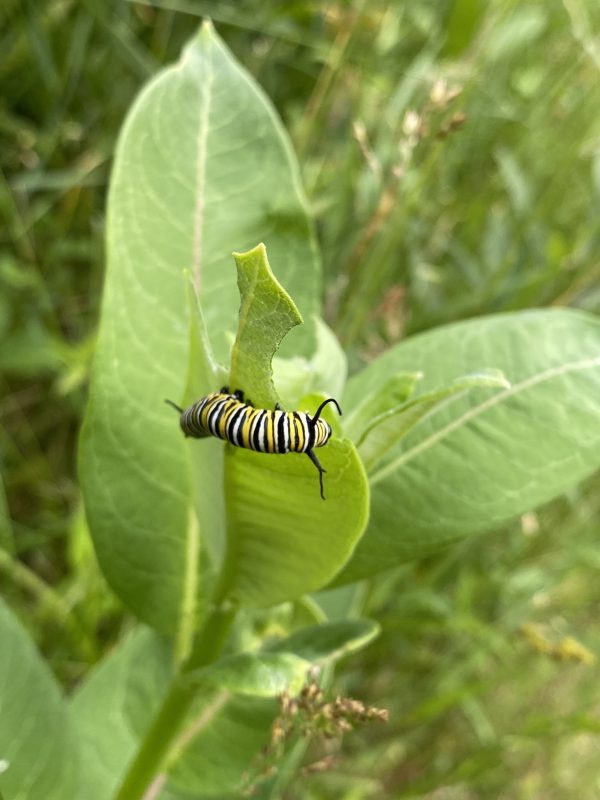
And what does he do? He captivates and nurtures it of course. He researches “how to raise Monarch butterflies at home”.
For now, the young man, still filled with wonder, is also hungry for knowledge. He wants to see nature unfold with his very own eyes.
Knowing a young caterpillar is very hungry, he ensures it is fed its favorite foods (milkweed).
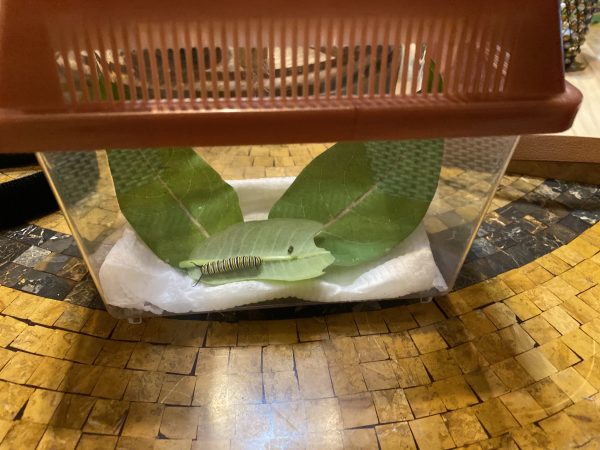
A hungry caterpillar on a bed of milkweed. He’ll eat for about two weeks.
Life Cycle
The caterpillar will eat for two weeks, and then begin to form its chrysalis (cocoons are specific to moths, chrysalis to butterflies).
Within two weeks, the caterpillar goes from eating, to resting and getting ready to cocoon, to forming the chrysalis. Amazing!
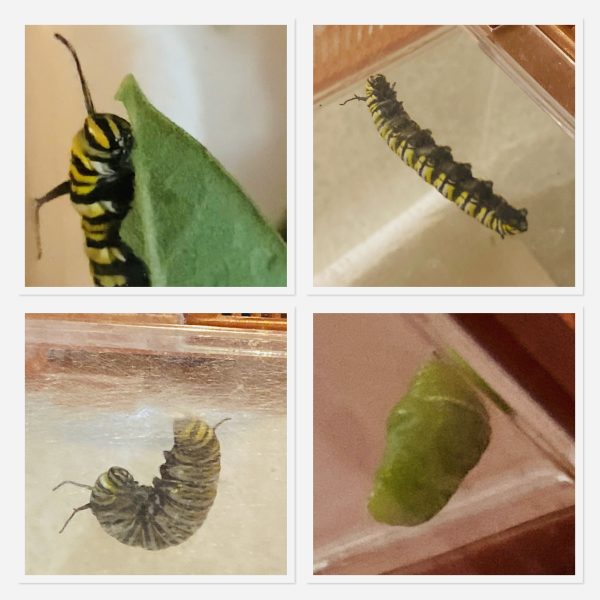
In the next ten days, a continued metamorphosis occurs within the chrysalis, until the butterfly gets ready to emerge one morning.
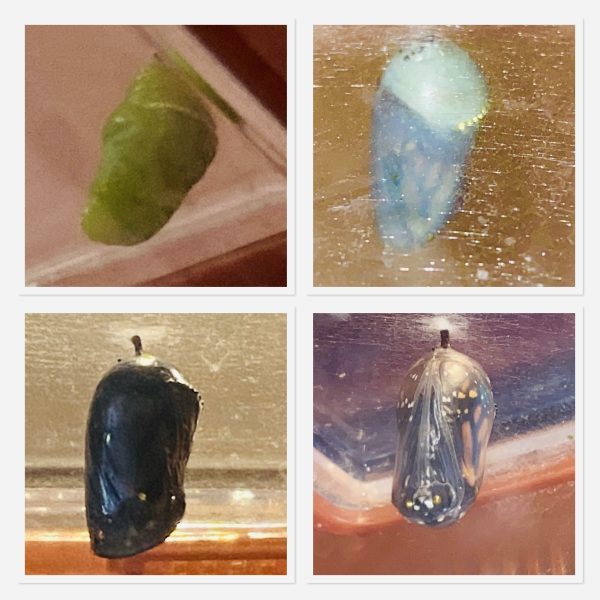
Chrysalis stages. Top left is first day of formation. Top right is 10pm the night before hatching. Bottom left is 10am the next morning. Bottom right is 12pm, shortly before hatching.
Once it emerges, it attaches itself to hang and dry, allowing its wings to unfold.
A Monarch has four stages and four generations. The stages are egg, larvae, pupa and adult butterfly. There are four generation (four butterflies passing through these four stages) within a year. The first generation lays eggs in early spring. The second-generation butterfly (perhaps this butterfly) lays them in June or July, and the process repeats for a third generation over the next two to six weeks (July to August). The fourth generation repeats the same, laying eggs in September or October, however they live longer and migrate to warmer climates from the north.
This butterfly is now free to fly away to find a mate!
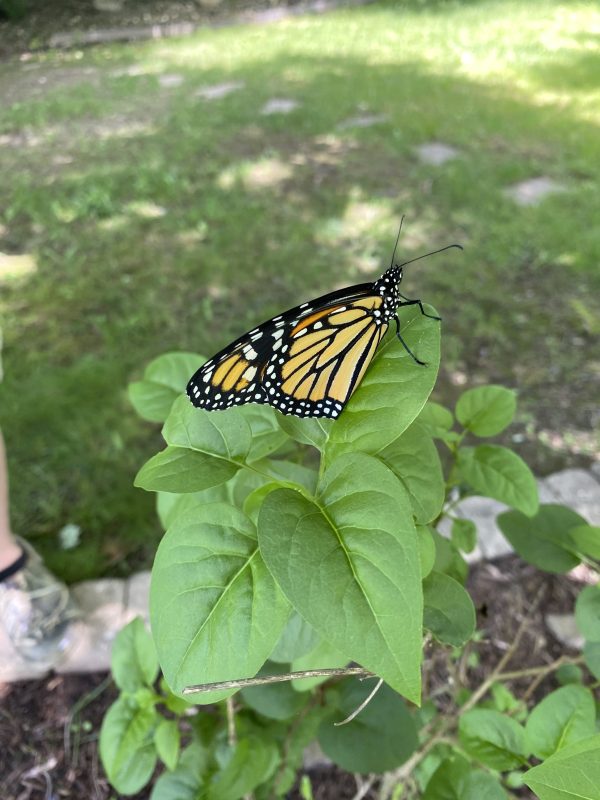
Released back to the wild.
Pollinators and Your Food
Why care about butterflies? Butterflies and honey bees are “pollinators” – they help pollinate plants, including the plants we eat. They help sustain ecosystems and support plant growth and reproduction. The Monarch is of particular interest. Over the past twenty years, the changes in breeding, migratory, and overwintering habitat has driven the population down.
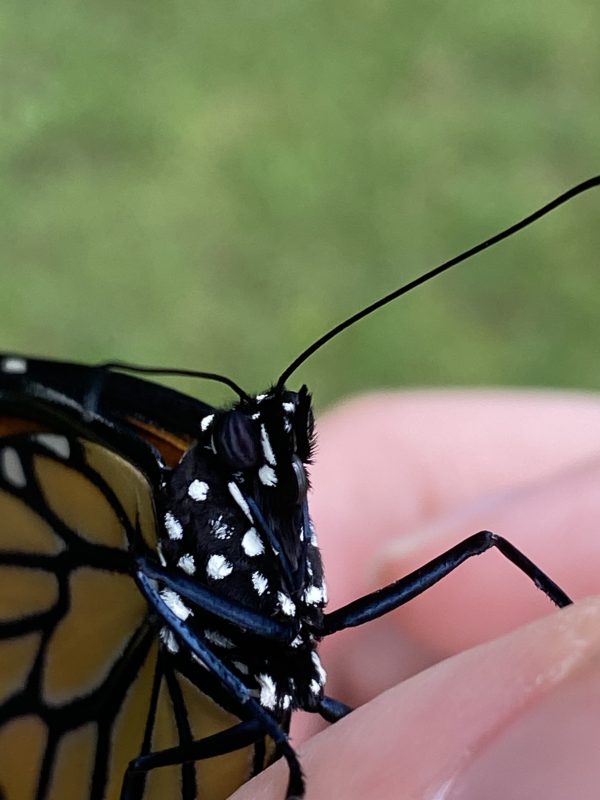
Butterflies, bees, moths, bats, birds and some beetles help pollinate plants.
When pollen grain moves from the male part (anther) of a flowering plant to the female part (stigma), pollination occurs. Wind and water can also move pollen grains from plant to plant, however up to 95% of flowering plants need the help of pollinators.
It’s estimated that pollinators are responsible for one of every three bites of food you eat. As we build more buildings, and remove more green-space, there’s less room for pollinators. We’ve planted milkweed in our flower beds, and other butterfly- and bee-attracting flowering plants.
The Butterfly Effect – How can you help?
- Plant flowers and other plants in your yard or garden that attract butterflies and bees
- Add milkweed to your landscape
- Educate others about the importance of pollinators
- Support community gardens
- Join the pollinator partnership
Share your story in the comments about a childhood passion…or a butterfly story!
